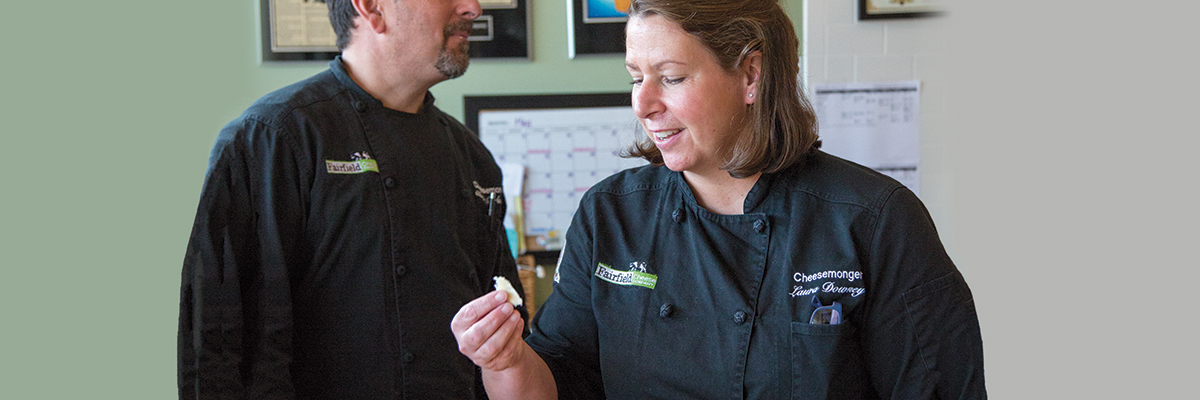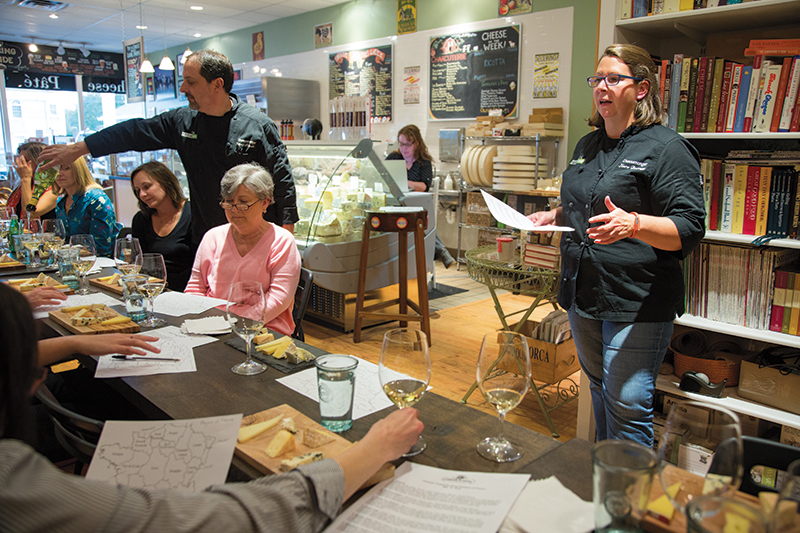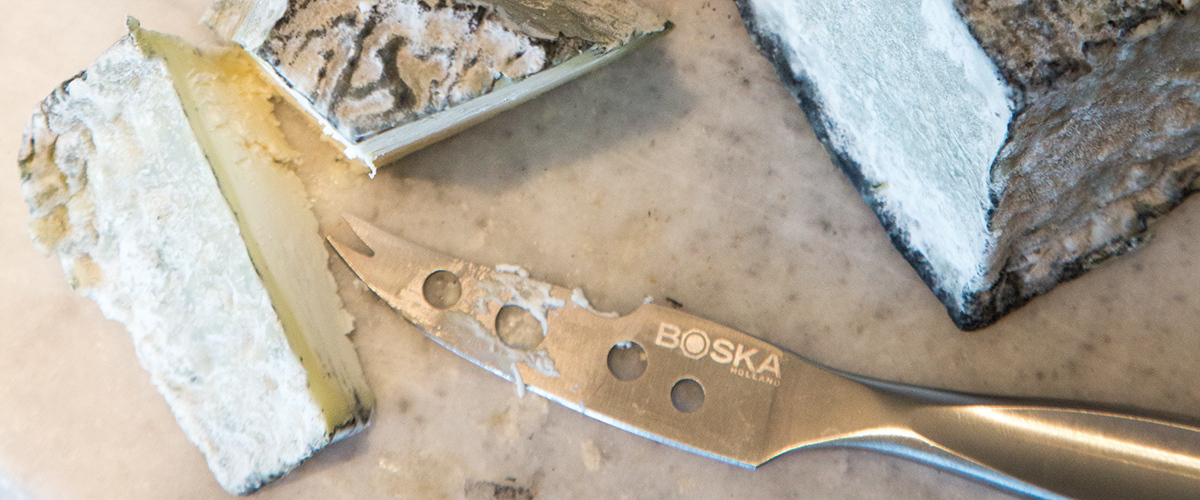Laura Downey is a certified cheese professional.
Seriously. She took a test—the first cheese test there ever was, actually, in order to call herself a cheesemonger. The test was developed by the American Cheese Society, and it was tough. “It was like studying for the bar,” says Downey.
Really, it’s akin to a test a wine aficionada must pass in order to call herself a sommelier. “I’m a cheese sommelier,” says Downey. And that seems about right. She can tell you how a cow’s lactation cycle affects the taste of cheese made from its milk, for example. She can eat a piece of cheese, blindfolded, and give you a good idea where it was made, whether it was crafted from goat’s milk, sheep’s milk, or cow’s, and then she’ll offer up a good wine with which to pair it.
There’s no doubt that Americans love their cheese—think about it: hot pizza, gooey panini, crisp quesadillas. Notice a theme here? A recent survey from the Kraft Foods Group indicates that 96 percent of Americans enjoy the beloved dairy product, and 36 percent would be willing to go a week without a cell phone to keep cheese in their diets. Fifty-seven percent would be willing to give up coffee for cheese if it came down to that. The Center for Science in the Public Interest, a consumer group, reported in 2013 that our cheese consumption has risen from eight pounds per American per year in 1970 to 23 pounds in 2013.
Downey gets it. In fact, she used to trek from her home in Fairfield, Conn., to Darien, Conn., just to visit the cheese shop there. (And we should be clear here that Downey wasn’t after anything Kraft had to offer; she was in the market for the high-end stuff—artisanal and farmstead cheeses made in small batches.) But she grew tired of making the drive down I-95, so she decided to open her own shop in Fairfield. She read everything she could about cheese and entrepreneurship. She attended conferences. She taught herself how to write a business plan, and she found the perfect location for her shop. She had been working in a party-planning business on Post Rd., right next to Harry’s Wine and Liquor, which had been around for 70 years. When the party business closed, she latched on to the location. Because, really, where else would you put a cheese shop than beside a store brimming with reds and whites and rosés? Downey even managed to tackle the toughest hurdle: landing an investor.
It was all looking as if it would work out, but that investor fell through, and she was left with a year’s worth of work, a solid business plan, and no partner. She headed to Harry’s for a bottle of wine to console herself, and it was there that she ran into Chris Palumbo, a local caterer she knew. She broke down in tears as she told him about the dream that was slipping through her fingers. “And he said, ‘I might be interested,’” recalls Downey. He headed home, discussed it with his wife, and called Downey at 8:30 the next morning. He had two words for her: “We’re in.”

Fairfield Cheese Company is a cozy little store with cheese accessories lining the walls. Items like slate and wood cheese boards, cheese knives, and gourmet crackers and jams. But the most glorious part of the shop is the cheese case, stocked with goods from America and Europe, ranging from fresh cheeses (mozzarella and feta) to bloomy (Brie and Camembert) to blue (Roquefort and Stilton).
Though it’s a relatively small part of the store, the case is the center of attention. Everything spans out from that glowing box. The locally sourced gift baskets that come in small wooden crates with the company logo need to be stocked with complementary flavors of honey and charcuterie. The chalkboard menus behind the counter are updated based on what’s inside the case—“Cheese of the Week: Ricotta—sweet, fresh, fluffy, local.” And most important, the staff must be educated about the subtleties of each individual cheese—what Downey calls the cheese’s story. Staff members know exactly where any given cheese came from, who the cheesemaker was, and the conditions that might affect the product. A shift in taste can depend on hundreds of factors: what the cows eat, the humidity, the length of time in the vat—even the mood of the maker.
Patrons are urged to sample the products as the staff point out the notes of the cheese—earthy, meaty, mushroomy, fruity. When the customer makes her selection, the cheese is freshly cut, wrapped, and slipped into a paper bag. When Downey or Palumbo hand the cheese over the counter, it feels like you’re getting a real treasure. After all, they selected that cheese especially for their customers based on what’s “good” on any given day. “A vintage in a wine is an entire year,” says Downey; “the vintage of a cheese is every single day.”
It’s an art, really, and one gaining in popularity, though Downey admits the up-and-coming cheese experts are a few years younger than she is. Cheesemongers tend to be in their late 20s and 30s, many with tattoos and a love of craft beer—folks who have jumped on the artisan- and local-food movements to create a promising career. Downey got a good look a few years back when she entered the Cheesemonger Invitational in New York. The competition was started by a gent named Adam Moskowitz, who told The New Yorker in 2013, “Two aspects make a cheese a cheese: the flavor, and the story. ... The cheesemonger knows that story. And nobody is celebrating him.” So Moskowitz decided he would be the one to do it.
The contest is fast-paced and fun (how many pieces of cheese could you wrap in 30 seconds?), but it certainly has a serious side. There’s a written test, for example, a blind taste test, and a portion in which the mongers have to create the “perfect bite,” an original recipe featuring their cheese of choice. Only 10 finalists of 50-plus contestants get to go on to the cutting-and-wrapping portion of the competition. The winner becomes the Champion of Cheese. While the title is a bit, well, let’s face it, cheesy, this is not a distinction to be taken lightly.
Downey didn’t win, but she did make it to 11th place, just missing the cutoff for the finals. Her plaque hangs in the store. Just proof that this woman, who raised two kids and worked as a buyer at Lord & Taylor before launching her own business, can certainly hang with the hipster crowd.

Only 200 wheels of a specially aged Comté Fort St. Antoine—a cheese that boasts fruity aromas with notes of pineapple and toasted walnuts—come to the U.S. every year. “For a little suburban shop to get two is huge,”Downey tells the 12 women who have gathered in the Fairfield Cheese Company store.
This is “Cheese School,” a monthly event that boils down to a cheese tasting and education. The most popular course, Cheese 101, gives students the basics, arming them with the seven categories in which cheese falls—fresh, semisoft, washed rind, bloomy, firm, hard, and blue—and schools them on how to go about cheese tasting, which is quite a bit like wine tasting. Tasters smell the cheese, much as you would sniff the cork of a fine bottle. They take it in slowly, notice the feel in their mouths, note how the taste begins—Is it spicy? Gamey? Pungent?—and how it finishes. While Downey is very serious about her cheese, she doesn’t approach this business with any arrogance—a stereotype one might associate with the world of fine wine.
Tonight’s course is delving into the “Great Cheeses of France,” and Downey is laughing and making small talk with her patrons. She’s wearing jeans and a company shirt as she dashes about filling water glasses for her students.
In front of each taster sits a cheese board and a glass of wine, picked up earlier at Harry’s. The women sip Chardonnay while tasting Valençay from the Loire Valley, Bio Camembert from Normandy, and that precious Comté Fort St. Antoine from Jura. They move to red wine as they dip into the Ossau-Iraty, the Munster Petit, and the Roquefort—the blue so concentrated and dark that if you look closely, you can see tiny crystals. A bite offers up a very slight crunch.
Downey has always been a bit of a foodie, which, to her, really just means cooking and eating what she calls “real food” as opposed to processed products. She grew up in Paris and London. “One thing I learned,” says Downey, “is that one-fifth of France is permanent pasture. There’s a dedication to food there. It’s part of their heritage.” And so it became a part of hers. But France, she learned, isn’t the only place to get good cheese. “We get a lot of customers who ask, ‘What do you have from France?’ It’s a fair enough question,” she says, “but a lot of the French cheeses we see in the U.S. are mass-produced.” As consumers, she tells her students, you really should be looking at French cheeses that are smaller in production, and come from places where the farmer and cheesemaker own the animals, milk the goats on site, make the cheese on the farm, and age it there before it goes to market. Just because it’s French, she tells them, doesn’t mean it’s good.
The same goes for the stereotype that Americans aren’t producing incredible cheese. Downey tells the story of a French couple who frequent the store. She often slips them some cheese made in America. “We don’t tell them what it is,” says Downey. “We just get it in their mouths, and they’re amazed.” It’s really all about what’s best and when. Camembert might taste completely different in January than it will in July, and that goes for all cheese, from the “stinky” cheeses that have what Downey calls “a bit of funk,” to the triple-creams. Cheese school lesson of the day: Don’t judge a cheese by its country of origin.
Maybe the Fairfield Cheese Company is “small and suburban”—it’s certainly no Murray’s in New York City—but it’s making a name for itself. So much so, that the Company now has a location in Greenwich, Conn. When the evening wraps up, Downey and Palumbo take their places behind the counter. It’s dark outside, but the women in the class are shopping, tasting, and purchasing triangular treasures from that cheese case that Downey is so proud of. Cheese School makes for a long day—she still has to clean up shop and head home—but Downey’s self-structured career is thriving, and she knows she’s found a little slice of heaven.
CHEESE WIZDOM
We all know cheese is great any time of year, but with the holidays around the corner, we wanted to know just what cheeses Downey would suggest for a cozy fall or winter get-together. Here are her top picks (with drink pairings, of course).
HARBISON Harbison is a soft cow’s milk cheese made by Jasper Hill Farm in Vermont. Its rich, gooey paste is slightly sweet and grassy, mushroomy and vegetal with a complexity that will leave you swooning. Harbison also makes a stunning presentation with its spruce bark wrapping and mottled blue and green molds on the bark. It is the perfect cheese to dig into while sitting by a roaring fire. I suggest digging in with a spoon, grabbing the best baguette you can find, and washing it down with a Belgian saison or your favorite pinot noir.
MONTGOMERY’S CHEDDAR This authentic cheddar is made with raw cow’s milk by James Montgomery in Somerset, England. Each 55-pound wheel is wrapped in a linen bandage and aged in a cave for at least 12 months. The flavors are deep, savory, meaty, and only slightly acidic with a balanced earthy finish. In the fall, it complements the season’s apples beautifully. Try it with an English-style dry cider, a hoppy IPA, or an earthy Côtes du Rhône.
GRUYÈRE 1655 Nothing says fall like melted cheese, and Gruyère 1655 fits the bill. While tremendous on a cheese board, it is an essential cheese for fondue, which we crave the minute the temperature drops. It is full of nutty, fruity flavor and has a smooth texture punctuated with protein crystals that crunch. Gruyère goes well with many white wines. If you can find the Swiss white Fendant du Valais (Chasselas), you will have the perfect match.

